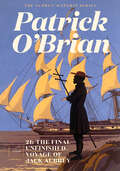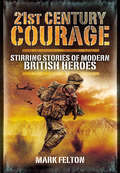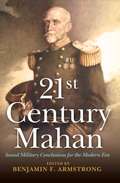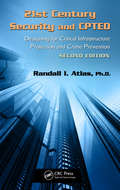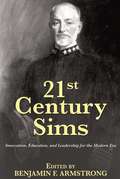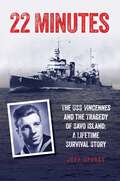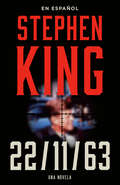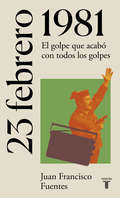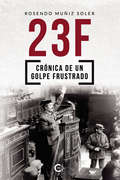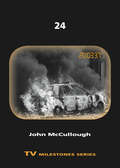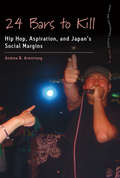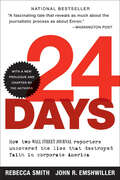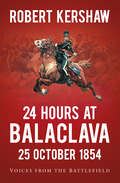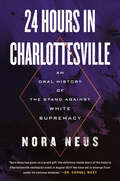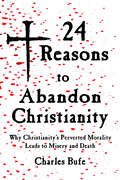- Table View
- List View
21: The Final Unfinished Voyage of Jack Aubrey (Vol. Book 21) (Aubrey/Maturin Novels) (Aubrey/Maturin Novels)
by Patrick O'BrianThe final, partial installment of the Aubrey/Maturin series in a beautiful new package. Patrick O’Brian’s Blue at the Mizzen—novel #20 in the widely celebrated Aubrey/Maturin series—ended with Jack Aubrey getting the news, in Chile, of his elevation to flag rank: rear admiral of the Blue Squadron, with orders to sail to the South Africa station. The next novel, unfinished and untitled at the time of the author’s death, would have been the chronicle of that mission, and much else besides. The three chapters left on O’Brian’s desk are presented here both in printed version—including his corrections to the typescript—and a facsimile of his manuscript, which goes several pages beyond the end of the typescript to include a duel between Stephen Maturin and an impertinent officer who is courting his fiancée. These chapters show that O’Brian’s powers of observation, his humor, and his understanding of his characters were undiminished to the end.
21D: Las claves de la crisis catalana en 21 artículos
by Agenda Pública<P>Lúcido e inteligente análisis sobre el procés. <P>Referéndum no pactado, incumplimiento de las leyes, proporcionalidad policial, luces y sombras de la aplicación del artículo 155, debilitamiento de la izquierda española, presos políticos, el papel de la Unión Europea, fuga de empresas, democratización y exhibición de identidad española, crisis constitucional y autonómica... <P>De la mano de Agenda Pública (agendapublica.elperiodico.com), tenemos aquí un lúcido y necesario repaso sobre el procés en Cataluña.
21st Century Courage: Stirring Stories of Modern British Heroes
by Mark FeltonThe book examines examples of outstanding courage exhibited by people living in modern Britain. These include British servicemen and servicewomen serving in Iraq and Afghanistan, police officers, and ordinary civilians in Britain and around the world. All of the cases cited have been awarded gallantry medals by the British government since 2000.The purpose of the book is to inspire modern British people. In the past, the heroes of Empire were well-known and respected, but since the Second World War people have tended to associate heroism with celebrity instead. We hear footballers and actors described as heroes, and this demeans the word, and the real heroes of modern British society. The generations that fought the First and Second World Wars have often been held up as the greatest generations of British people. This book shows Britons that the kind of grit, determination, courage and willingness to have a go exhibited by previous generations are as alive now as they ever were, and heroes can come from all walks of life and all ethnic groups in modern Britain.
21st Century Courage: Stirring Stories of Modern British Heroes
by Mark FeltonThe book examines examples of outstanding courage exhibited by people living in modern Britain. These include British servicemen and servicewomen serving in Iraq and Afghanistan, police officers, and ordinary civilians in Britain and around the world. All of the cases cited have been awarded gallantry medals by the British government since 2000.The purpose of the book is to inspire modern British people. In the past, the heroes of Empire were well-known and respected, but since the Second World War people have tended to associate heroism with celebrity instead. We hear footballers and actors described as heroes, and this demeans the word, and the real heroes of modern British society. The generations that fought the First and Second World Wars have often been held up as the greatest generations of British people. This book shows Britons that the kind of grit, determination, courage and willingness to have a go exhibited by previous generations are as alive now as they ever were, and heroes can come from all walks of life and all ethnic groups in modern Britain.
21st Century Ellis
by Edited by B. A. FriedmanFor years, the Marine Corps has touted the prescience of Lieutenant Colonel "Pete” Ellis, USMC, who predicted in 1921 that the United States would fight Japan and how the Pacific Theater would be won. Now, for the first time, those predictions and other works by the "amphibious prophet” are available in print. Included is two works by Ellis on naval and amphibious operations, including Advanced Base Operations in Micronesia, the study of tactics and operations in the Pacific Ocean that the United States Navy and Marine Corps would use to win the war against Imperial Japan. Ellis describes the form and functions of a modern Marine Corps designed to win its Nation’s battles. Ellis’ ideas about how the Marine Corps should fight are still in use throughout the world today. Ellis’ ideas on amphibious operations are well known, but his ideas on counterinsurgency and conventional war have been overshadowed and forgotten. Ellis wrote two articles based on his warfighting experiences in the Philippines and as part of the American Expeditionary Force in Europe during World War I. These articles, last published in the early 1920’s, are both republished in this book and show Ellis as a prescient thinker who was ahead of his time. Ellis identifies concepts that the U. S. military struggles with even today, and that other thinkers would not identify for decades after Ellis’ death. Also included are six essays by the editor, introducing the ideas of Pete Ellis and putting them in a modern context. As the United States turns its focus to the Pacific, Ellis’ ideas can inform policymakers on the dynamics of strategy and warfare in the vast reaches of the Pacific Ocean. Edited by Captain B. A. Friedman, USMC, 21st Century Ellis reveals the strategic insights of Pete Ellis for then and now.
21st Century Mahan
by Benjamin ArmstrongAlfred Thayer Mahan's The Influence of Seapower upon History is well known to students of naval history and strategy, but his other writings are often dismissed as irrelevant to today's problems. This collection of five of Mahan's essays, along with Benjamin Armstrong's informative introductions, illustrates why Mahan's work remains relevant to the 21st century and how it can help develop our strategic thinking. People misunderstand Mahan, the editor argues, because they have read only what others say about him, not what Mahan wrote himself. Armstrong's analysis is derived directly from Mahan's own writings. From the challenges of bureaucratic organization and the pit falls of staff duty, to the development of global strategy and fleet composition, to illustrations of effective combat leadership, Armstrong demonstrates that Mahan's ideas continue to provide today's readers with a solid foundation to address the challenges of a rapidly globalizing world.
21st Century Security and CPTED: Designing for Critical Infrastructure Protection and Crime Prevention, Second Edition
by Randall I. AtlasThe concept of Crime Prevention Through Environmental Design (CPTED) has undergone dramatic changes over the last several decades since C. Ray Jeffery coined the term in the early 1970s, and Tim Crowe wrote the first CPTED applications book. The second edition of 21st Century Security and CPTED includes the latest theory, knowledge, and practice of
21st Century Sims
by Edited by Benjamin F. ArmstrongFor more than two decades at the beginning of the 20th century William S. Sims was at the forefront of naval affairs. From the revolution in naval gunnery that he led as a junior officer, to his advocacy for the Dreadnaught style all-big-gun battleship, to his development of torpedo boat and destroyer operations, he was a central figure in helping to prepare the U. S. Navy for World War I. During the war he served as the senior naval commander in Europe and was instrumental in the establishment of the convoy system that won the Battle of the Atlantic. Following the war his leadership as President of the Naval War College established the foundations of the creative and innovative Navy that would develop the operating concepts for submarines and aircraft carriers which would lead to success in World War II. Despite his dramatic impact on the U. S. Navy in the first half of the 20th century, Sims is a relatively unknown figure today. Overshadowed in our memory by the World War II generation of strategic Admirals, like Chester Nimitz and Raymond Spruance, he receives little attention from historians or professional naval officers. Despite the fact that he won a Pulitzer Prize for history, hardly anyone reads the books or articles he left as his legacy. This collection of six essays written by Sims illustrates why his thinking and leadership are relevant to the challenges faced in the 21st century. From the perils of military conservatism, to the responsibilities of the professional officer, to military downsizing and reform, he helped lay the foundations of the modern Navy. Armstrong’s introductions and analysis of these essays links them directly to the issues of innovation, professional education, and leadership that are as important at the start of this century as they were at the start of the last.
21st-Century Narratives of World History: Global and Multidisciplinary Perspectives
by R. Charles WellerThis book makes a unique and timely contribution to world/global historical studies and related fields. It places essential world historical frameworks by top scholars in the field today in clear, direct relation to and conversation with one other, offering them opportunity to enrich, elucidate and, at times, challenge one another. It thereby aims to: (1) offer world historians opportunity to critically reflect upon and refine their essential interpretational frameworks, (2) facilitate more effective and nuanced teaching and learning in and beyond the classroom, (3) provide accessible world historical contexts for specialized areas of historical as well as other fields of research in the humanities, social sciences and sciences, and (4) promote comparative historiographical critique which (a) helps identify continuing research questions for the field of world history in particular, as well as (b) further global peace and dialogue in relation to varying views of our ever-increasingly interconnected, interdependent, multicultural, and globalized world and its shared though diverse and sometimes contested history.
22 Minutes: The USS Vincennes and the Tragedy of Savo Island: A Lifetime Survival Story
by Jeff SpevakErnie Coleman survived the worst open-sea defeat in US Navy history. But he paid a price and buried the horrific memories for decades.In the manner of Mitch Albom&’s highly successful Tuesdays with Morrie, 22 Minutes is a searing account of a survivor coming to terms with an incident he had suppressed for sixty years and the writer who painstakingly put together the clues about what had happened.Author Jeff Spevak was confronted with a dilemma: How do you tell the story of a man who can&’t bring himself to talk about the most epic moment of his life? A clever fellow who&’d scrapped to survive in a fashion that seems quaint today, Coleman tested himself as a teenager by swimming across lakes, building homes from foraged lumber, running a Navy carpentry shop as though he were a member of the scamming crew of McHale&’s Navy. He was a self-taught sailor who&’d become a legend on Lake Ontario. At age 96, Ernie was still sailing.Ernie Coleman talked of his life frankly – his honest remembrances of brawls and regrets. But he refused to talk about the one thing that had haunted him for decades: the sinking of his ship the Vincennes and his nightmares of men screaming in the burning sea, of incinerated corpses still manning the anti-aircraft guns. Through interviews with Coleman's family and others who knew Coleman, and arduous research Spevak finally put together what had occurred the night of the horrendous loss of his ship, the USS Vincennes, a cruiser sunk during the World War II Battle of Savo Island off Guadalcanal. Four big ships and more than 1,000 sailors were lost that night in a 22-minute battle, the worst open-sea defeat in the history of the United States Navy.Gripping, moving, highly personal, 22 Minutes is Coleman&’s story of the incident he had buried for more than 60 years. Did Ernie pursue sailing with such intensity, at a time when most men his age are sitting in front of the television, waiting for the end, so that he did not have to close his eyes and remember that night on the Vincennes?&“I know why those kids come back from Afghanistan and shoot themselves,&” he said sadly one morning, sitting on the shady patio at his home. &“You lay awake at night, reacting, reacting, reacting. Because it&’s so real.&”22 Minutes has enormous potential to match some of the best-selling first-hand World War II memoirs published in recent years.
22 Yards
by Tuhin A. SinhaIt's exactly twenty-five years after India's spectacular World Cup victory at Lords, and Indian cricket captain Mayank Pradhan is preparing for the match of his life: the Twenty-20 World Cup final.
22/11/63: A Novel
by Stephen KingEl 22 de noviembre de 1963, tres disparos resonaron en Dallas. Murió el presidente Kennedy, y el mundo cambió. ¿Qué harías tú si pudieras impedirlo? Jake Epping es un profesor de ingles en una preparatoria en Lisbon Falls, Maine, quien además complementa su salario dando clases nocturnas para adultos. Un día, Jake recibe un ensayo escrito por uno de sus estudiantes—una aterradora historia sobre una noche de hace cincuenta años, en la que el padre de Harry Dunning asesino a su esposa y a dos de sus hijos con un martillo. Harry, quien escribe el ensayo, logro escapar con solo una herida en la pierna, que hasta ese dia le causa problemas al caminar. Poco después, Al, el propietario de un restaurante local y amigo de Jake, le cuenta un secreto: el almacén del restaurante es un portal a 1958. Así es como Jake se encuentra en medio de la aventura mas arriesgada de su vida: impedir el asesinato del presidente John F. Kennedy. En esta nueva vida, Jake—ahora George Amberson—emprende la búsqueda del solitario Lee Harvey Oswald entre canciones de Elvis, autos de moda y humo de cigarrillos, ayudado por una bella bibliotecaria llamada Sadie Dunhill, quien se convertirá en el amor de su vida.
23 Things They Don't Tell You About Capitalism
by Ha-Joon ChangOne of the world's most respected economists and author of the international bestseller "Bad Samaritans" equips readers with an understanding of how global capitalism works--and doesn't.
23 de febrero de 1981: El día en que fracasó el golpe de Estado
by Juan Francisco FuentesNo todos los días son iguales. Una colección única que cuenta nuestro largo siglo XX en 7 libros para 7 fechas clave. Solemos abordar la historia a partir de arcos de tiempo dilatados. Pero ¿qué sucedería si, por una vez, centráramos la atención en los instantes concretos que más han marcado nuestro pasado colectivo? Los protagonistas, sus acciones, sus emociones, sus deseos, sus dudas y sus errores pasan a ocupar el centro del relato, irrumpen con la fuerza de la imprevisibilidad, y los revivimos como si fuera la primera vez. En esta novedosa colección, algunos de los mejores historiadores nos muestran que nada puede darse por sentado, y cómo acontecimientos concretos pueden dejar una profunda huella en un país. El 23 de febrero de 1981 la tediosa votación de investidura de Leopoldo Calvo-Sotelo fue interrumpida por la aparición de un grupo de guardias civiles que enarbolaban sus armas. La joven democracia española parecía que iba a terminar en medio de una confusión de bigotes, disparos y tricornios. Sin embargo, el resultado fue el contrario, el sistema se fortaleció y fue el golpe que acabó con siglo y medio de golpes. Juan Francisco Fuentes, uno de los mejores historiadores de la España contemporánea, repasa en este esencial volumen cómo se llegó al 23F, qué ocurrió ese día, y las mitificaciones y teorías de la conspiración a que ha dado pie en los últimos cuarenta años.
23F: Crónica de un golpe frustrado
by Rosendo Muñiz SolerUn análisis del 23F. Cuando se inició la transición en pro de lograr una democracia para España, sus primeros compases estuvieron regodeados de un temor constante a que se produjera un golpe de Estado propiciado por algún militar resabiado, de los que estaban en contra de que se aprobaran las comunidades autónomas de las que se hacía principal responsable a Cataluña. En cuanto al golpe del 23F, al final solo se trató de un tongo propiciado para salvaguardar aquella anhelada democracia.
23rd Fighter Group
by Jim Laurier Carl MolesworthStaffed with inexperienced USAAF pilots and led by a handful of seasoned veterans of the American Volunteer Group (AVG), the 23rd FG was formed in the field at Kunming, in China, on July 4, 1942 and flew combat missions that same day. The group's three squadrons - the 74th, 75th and 76th Fighter Squadrons - were initially equipped with war-weary P-40s handed down from the AVG. These were supplemented by the attached 16th FS, flying new P-40Es, and all squadrons adorned the noses of their airplanes with fearsome and iconic sharksmouth designs.The 23rd FG fought a guerrilla war against the Japanese, steadily moving pilots and aircraft from one remote air base to another to keep the enemy off balance. Because China could only be supplied by air from India, there were constant shortages of aircraft, fuel and ammunition with which to contend. The 23rd FG met these challenges head-on and by the end of the war its pilots had compiled a score of 594 aerial victories and nearly 400 ground kills. Among the 47 aces who flew in the 23rd were colorful characters such as David L 'Tex' Hill, Robert L 'Bob' Scott and Clinton D 'Casey'. The human cost was high, however - 126 pilots lost their lives in China while serving in the 23rd.
24
by John McculloughFor eight seasons between 2001 and 2010, Fox's 24 garnered critical accolades and became one of the most watched and discussed shows in primetime. In an innovative premise, the show's hour-long episodes were meant to represent a real-time hour of the story, so that each twenty-four-episode season depicts a single day in the life of its characters. Influential as a popular hit, 24 was also closely linked with the "culture of fear" that dominated the post-9/11 period. In this insightful study, author John McCullough demonstrates that the series was not only unique and trendsetting, but also a complex creative response to its historical context. In three chapters, McCullough looks at 24's form, style, and overarching themes and meanings. He argues that although the series is driven by the political and cultural shifts brought on by the War on Terror, it is routinely out of step with real history. Using Linda Williams's distinction between the melodramatic mode and melodrama as a genre, McCullough explores 24's use of the action-adventure and spy thriller forms with particular attention paid to the series' hero, Jack Bauer, who is depicted as a tragic hero perpetually in search of a return to innocence. Ultimately, McCullough finds that the series' distinction lies less in its faithful re-creation of the history of the WOT than in its evocation of the sense of crises and paranoia that defined the period. McCullough also analyzes 24 as a response to television culture in the "post-network" age, characterized by reality TV's populist appeal and visceral content, on the one hand, and sophisticated boutique cable programming ("quality TV"), on the other. McCullough demonstrates that 24 engaged not only with the most pressing issues of world history and the geopolitics of its time, including terrrorism, neoliberalism, and the state of exception, but, on the strength of its form and style, also represents significant global trends in television culture. Fans of the show and media history scholars will appreciate this thorough study.
24 Bars to Kill: Hip Hop, Aspiration, and Japan's Social Margins (Dance and Performance Studies #14)
by Andrew B. ArmstrongThe most clearly identifiable and popular form of Japanese hip-hop, “ghetto” or “gangsta” music has much in common with its corresponding American subgenres, including its portrayal of life on the margins, confrontational style, and aspirational “rags-to-riches” narratives. Contrary to depictions of an ethnically and economically homogeneous Japan, gangsta J-hop gives voice to the suffering, deprivation, and social exclusion experienced by many modern Japanese. 24 Bars to Kill offers a fascinating ethnographic account of this music as well as the subculture around it, showing how gangsta hip-hop arises from widespread dissatisfaction and malaise.
24 Days: How Two Wall Street Journal Reporters Uncovered the Lies that Destroyed Faith in Corporate America
by John R. Emshwiller Rebecca SmithNATIONAL BESTSELLER—with a new prologue and chapter by the authors. “A fascinating tale that reveals as much about the journalistic process as about Enron.” —The Washington PostThis is the story of Rebecca Smith and John R. Emshwiller, the two reporters who led the Wall Street Journal’s reporting on Enron and uncovered the unorthodox partnerships at the heart of the scandal through skill, luck, and relentless determination.It all started in August 2001when Emshwiller was assigned to write a supposedly simple article on the unexpected resignation of Enron CEO Jeff Skilling. During his research, Emshwiller uncovered a buried reference to an off-balance-sheet partnership called LJM. Little did he know, this was the start of a fast and furious ride through the remarkable downfall of a once highly-prized company.Written in an intense, fast paced narrative style, 24 Days tells the gripping story of the colossal collapse of what would become the world’s most notorious corporation. The reader follows along as Smith and Emshwiller continue to uncover new partnerships and self-dealing among the highest levels of Enron’s management. As they publish articles detailing their findings in the Journal, Wall Street and individual investors have a crisis of confidence and start selling Enron stock at unprecedented levels of volume. In the end—24 short days later—Enron had completely collapsed, erasing 16 years of growth and losing $19 billion in market value while watching the stock drop from $33.84 to $8.41. Not only was the company destroyed, but investors and retired employees were completely wiped out—all the while Enron executives were collecting millions of dollars.“Gripping . . . the best of the Enron books yet.” —USA Today
24 Hours at Agincourt
by Michael JonesAgincourt was an astonishing clash of arms, a pivotal moment in the Hundred Years War and the history of warfare in general.King Henry V’s exhausted troops were preparing for certain defeat as they faced a far larger French army. What was to take place in the following 24 hours, it seemed only the miraculous intervention of God could explain.Interlacing eyewitness accounts, background chronicle and documentary sources with a new interpretation of the battle’s onset, acclaimed military historian Michael Jones takes the reader into the heart of this extraordinary feat of arms.
24 Hours at Balaclava: Voices from the Battlefield
by Robert KershawIn 1854 Britain and France were at war to save ‘poor little Turkey’, the crumbling Ottoman Empire, from the menace of Russian expansionism. On 25 October they were nine days into what would become an eleven-month siege, with little to show for it. Suddenly, from behind them came the unmistakeable sound of cannon. The Russians had arrived. Vastly outnumbered, the British gained an unlikely upper hand with the charge of the Heavy Brigade and the efforts of the Thin Red Line. But then, within two hours of achieving near victory, the British squandered it in dramatic style with the charge of the Light Brigade. Using eyewitness accounts, letters and diaries, acclaimed military historian Robert Kershaw presents a new, intimate look at the Battle of Balaclava, from the perspective of the men who ‘saw little and knew even less’. Come down from the Heights and see the real story of one of the most ill-fated military expeditions in British history.
24 Hours at the Somme: 1 July 1916
by Robert KershawThe first day of the Somme has had more of a widespread emotional impact on the psyche of the British public than any other battle in history. Now, 100 years later, Robert Kershaw attempts to understand the carnage, using the voices of the British and German soldiers who lived through that awful day.In the early hours of 1 July 1916, the British General staff placed its faith in patriotism and guts, believing that one ‘Big Push’ would bring on the end of the Great War. By sunset, there were 57,470 men – more than half the size of the present-day British Army – who lay dead, missing or wounded. On that day hope died.Juxtaposing the British trench view against that from the German parapet, Kershaw draws on eyewitness accounts, memories and letters to expose the true horror of that day. Amongst the mud, gore and stench of death, there are also stories of humanity and resilience, of all-embracing comradeship and gritty patriotic British spirit. However it was this very emotion which ultimately caused thousands of young men to sacrifice themselves on the Somme.
24 Hours in Charlottesville: An Oral History of the Stand Against White Supremacy
by Nora NeusA gripping oral history of the white nationalist riots that shook the nation and signaled the arrival of a galvanizing new era, told from the perspective of the anti-racist activists who fought backOn August 11 and 12, 2017, armed neo-Nazi demonstrators descended on the University of Virginia campus and downtown Charlottesville. When they assaulted antiracist counterprotesters, the police failed to intervene, and events culminated in the murder of counterprotestor Heather Heyer.In this book, Emmy-nominated CNN journalist and former Charlottesville resident Nora Neus crafts an extraordinary account from the voices of the students, faith leaders, politicians, and community members who were there. Through a vivid collage of original interviews, new statements from Charlottesville mayor Mike Signer and Virginia Governor Terry McAuliffe, social media posts, court testimony, and government reports, this book portrays the arrival of white supremacist demonstrators, the interfaith service held in response, the tiki torch march on the university campus, the protests and counterprotests in downtown Charlottesville the next day, and the deadly car attack. 24 Hours in Charlottesville will also feature never-before-disclosed information from activists and city government leaders, including Charlottesville mayor Mike Signer.
24 Reasons to Abandon Christianity: Why Christianity's Perverted Morality Leads to Misery and Death
by Charles BufeTaking up where Christopher Hitchens' God Is Not Great left off, 24 Reasons to Abandon Christianity reveals Christianity's cruelty, dishonesty, fear-mongering, hypocrisy, misogyny, homophobia, dogmatism, and authoritarianism, and all of the misery, destruction, and death caused by these things. 24 Reasons to Abandon Christianity also reveals the roots of these characteristics, and why Christianity leads to all of these evils. While the book treats serious topics, its tone—much like Hitchens' book—is analytical, but also breezy and biting.
24/7 Politics: Cable Television and the Fragmenting of America from Watergate to Fox News (Politics and Society in Modern America #148)
by Kathryn Cramer BrownellHow cable television upended American political life in the pursuit of profits and influenceAs television began to overtake the political landscape in the 1960s, network broadcast companies, bolstered by powerful lobbying interests, dominated screens across the nation. Yet over the next three decades, the expansion of a different technology, cable, changed all of this. 24/7 Politics tells the story of how the cable industry worked with political leaders to create an entirely new approach to television, one that tethered politics to profits and divided and distracted Americans by feeding their appetite for entertainment—frequently at the expense of fostering responsible citizenship.In this timely and provocative book, Kathryn Cramer Brownell argues that cable television itself is not to blame for today&’s rampant polarization and scandal politics—the intentional restructuring of television as a political institution is. She describes how cable innovations—from C-SPAN coverage of congressional debates in the 1980s to MTV&’s foray into presidential politics in the 1990s—took on network broadcasting using market forces, giving rise to a more decentralized media world. Brownell shows how cable became an unstoppable medium for political communication that prioritized cult followings and loyalty to individual brands, fundamentally reshaped party politics, and, in the process, sowed the seeds of democratic upheaval.24/7 Politics reveals how cable TV created new possibilities for antiestablishment voices and opened a pathway to political prominence for seemingly unlikely figures like Donald Trump by playing to narrow audiences and cultivating division instead of common ground.
